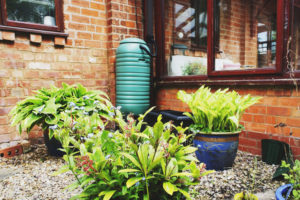7 Ways to Improve Yard Drainage
Reliable Basement is now part of ULB-DRY Waterproofing . You are being redirected to similar content on ULB-DRY Waterproofing’s website.
If you are not redirected within 5 seconds, please click here.

Standing water on your property isn’t just an eyesore—it can also lead to soil erosion, foundation cracks, and basement leaks. Here are seven ways to improve the drainage in your yard and protect your home’s structural integrity in the process.
- Extend or bury the downspouts and sump pump discharge line: Before you start digging a trench, determine where the water is coming from. In many cases, directing runoff away from the foundation is as easy as extending the downspouts. Redirecting your sump pump’s discharge pipe away from low spots can also help. When these measures aren’t enough, consider burying the lines to divert water at least 10 to 15 feet away from the foundation.
- Install rain barrels: Do away with water running off the roof altogether by setting up rain barrels. When your yard doesn’t have to contend with runoff from your house, you may find that it drains much better. Rain barrels then give you access to free water for your lawn and garden later when rainfall is low.
- Build up the soil or create a berm: If an eroded low spot on your property is nothing but a nuisance, fill it in with new soil. You can also build a berm, or mound dirt, to intentionally redirect water flow where you want it. This is especially effective for improving garden drainage when specific beds tend to flood.
- Build a rain garden: Embrace your flooded flower bed and convert it into a rain garden. Filled with water-loving plants, rain gardens catch and hold the runoff until it drains away. Native plants with deep, fibrous roots usually work best in rain gardens.
- Add an underground drain pipe: Drain the water away from a low spot through an underground pipe. This involves digging a trench and burying a drainpipe. For this idea to work, the discharge outlet location must be lower than the spot that’s flooding on your property.
- Install a French drain: Rather than carrying runoff away in a drainpipe, a French drain helps water percolate into the soil faster, so it dissipates rather than pooling on your property. The fundamentals of a French drain include a perforated pipe, sheathed in a filter sock and surrounded by gravel. No inlet or outlet is required, and you can install any length of pipe you want.
- Create a dry well: When a French drain isn’t enough for your soggy property, attach a dry well to the end of it. This is simply a large hole lined with a perforated barrel and filled with gravel that holds excess water until it soaks into the ground. You can install a dry well with or without a French drain.
Reliable Basement Services can help you implement any combination of these solutions to improve the drainage in your yard. To learn more about each option, or to request a free quote, please contact us today at (630) 318-4888.
